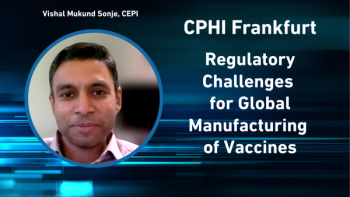
- Pharmaceutical Technology-08-01-2007
- Volume 2007 Supplement
- Issue 3
Dynamics of India's Life Sciences Outsourcing Industry
The tightening of intellectual property rights in India under GATT/TRIPS was a crucial inflection point for pharmaceutical outsourcing in India.
Since the implementation of the patent regime under the General Agreement on Tariffs and Trade/Agreement on Trade-Related Aspects of Intellectual Property Rights (GATT/TRIPS) in India on Jan. 1, 2005, the Indian biotechnology and pharmaceutical industries have metamorphosed, and in the past two years, have seen three significant changes:
- A higher comfort level among global pharmaceutical, biotechnology, and fine chemicals companies in working in India and with Indian companies
- An increased appetite of global investors (particularly venture capital and private equity firms) to invest in Indian fine chemicals, pharmaceutical, biotechnology, and contract-research and manufacturing services companies
- Eagerness and advanced capabilities of Indian executives to become global players, especially through inorganic growth.
India's position in pharmaceutical outsourcing
Global biotechnology and pharmaceutical companies are attracted to India for several reasons:
- Availability of English-speaking scientific talent
- A vertically integrated industry with a range of capabilities
- Experience and knowledge of current good manufacturing practices, good laboratory practices, and guidelines under the International Conference on Harmonization
- The highest number of plants outside the United States inspected and approved by USFood and Drug Administration
- Transparency and ease of doing business
- Lower cost
Evolution of pharmaceutical outsourcing in India
From the early 1990s to 2005, India's main attraction was from generics companies or fine chemicals companies, especially to source advanced intermediates and active pharmaceutical ingredients (APIs) or to carry out contract development of abbreviated new drug applications. India did not register on the radars of decision-makers at global biotechnology and pharmaceutical companies for innovation, collaboration, drug discovery, manufacturing of complex finished dosages, and licensing. During this period, the relationships between Indian and global companies can be categorized as lower-level procurement and nonstrategic. This situation was mainly attributed to the huge concern over the protection of intellectual property that loomed in the minds of executives at multinational biotechnology and pharmaceutical companies. Even though India was a signatory to the GATT/TRIPS patent regime, the actual implementation would not occur until Jan. 1, 2005, leading to a wait-and-see approach.
There also were relatively few options for partnering with India-based companies. Options included:
- Indian pharmaceutical firms focused mainly on generics, creating possible patent infringement or conflict-of-interest
- Pure API and fine chemicals companies with limited capabilities and capacities
- Government laboratories
- Less than a handful of pure contract-research and manufacturing companies.
In anticipating the implementation of the patent regime, Indian companies such as Nicholas Piramal (NPIL), Glenmark, Ranbaxy, Zydus Healthcare, and Dr. Reddy's Laboratories ramped up their capabilities in drug discovery for new chemical entities (NCEs) in a more significant and faster manner than anticipated. These companies followed various business models, including setting up wholly owned subsidiaries or divisions or investing in a new entity.
A new crop of companies focused solely on contract-research and manufacturing services also emerged. Examples included Syngene (a subsidiary of Biocon), Hikal, GVK Bio, Jubilant Organosys, Siro Clinpharm, Acunova Life Sciences, Chembiotek, Dishman Pharmaceuticals & Chemicals, and Research Support International Limited. These firms were pure-play service providers. Because they provided low or no conflict of interest with their own generics programs, they became lower-risk partnering options for global buyers. Global buyers had a choice in working with companies that could provide an individual set of products or services, such as Syngene's drug-discovery services, Siro Clinpharm's clinical trials, or Hikal's synthesis of APIs.
Most innovator companies started working with Indian companies on pure sourcing or outsourcing deals to source analogs, libraries, informatics work, advanced intermediates, custom synthesis, and simple clinical trials or even rescue trials. These projects provided low risk and less of a bureaucratic hurdle than more intricate risk- and reward-sharing deals, which came during the past two years (see Figure 1).
Figure 1
Increased outsourcing to India
Today, major biotech, pharmaceutical, and fine chemicals companies are leveraging India in the form of outsourcing, offshoring, or licensing and collaborations deals (see Figure 2). Companies such as Wyeth and Bristol-Myers Squibb (BMS)are entering India with build-operate-and transfer deals as evidenced by Wyeth's outsourcing pact for synthetic chemistry research with GVK Bio and BMS's deal with Syngene under which Syngene will build and operate a 400-scientist research and development center for BMS.
Figure 2
Two other deals showcase the increasing comfort level of global companies with India. Under a 2007 deal with Eli Lilly, NPILwill develop and, in certain regions, commercialize a select group of Lilly's preclinical drug candidates in multiple therapeutic areas. The companies will equally share risks and rewards, and NPIL is responsible for designing and executing the global clinical development program, including investigational new drug-enabling nonclinical studies and human clinical trials up to Phase III. NPIL will receive a call-back payment and potential milestone payments of up to $100 million, plus royalties on sales upon successful launch of the first compound.
Advinus Therapeutics and Merck and Co. formed a pact in 2006 for the discovery and development of metabolic drugs. Under the deal, Advinus receives an upfront payment, milestone payments up to $74.5 million for each drug target, and potential royalties on sales from products of the collaboration.
Several factors account for the increased comfort level and interest of global companies:
- Scientists of Indian origin with drug-discovery and clinical-trial experience at global firms are moving back to India to work at Indian companies or to start their own ventures
- Ability of Indian companies to prove that they can create value in a time and cost-effective manner
- Emergence of pure-service providers
- State-of-the-art infrastructure and a wide range of services
- Ability of Indian companies to offer a complex and broad spectrum of services and products in a transparent manner
- Opportunities in India's healthcare market based on the emergence of a 300-million-people-strong middle class
- Most global companies have or are setting up local offices to manage relationships and projects in India
- Creative deal-structuring by Indian executives for sharing risks and rewards.
Stronger appetite of global investors for India
After China, India is the most sought-after country of choice by global investors for foreign direct investments (1). India's liberal and attractive investment policies, coupled with highly liquid financial markets, are key reasons for this growth. Creative deals are being struck between Indian companies and investors where funds are being used to finance specific projects instead of simply investing in existing companies or diluting current shareholders. Dr. Reddy's Laboratories used this strategy in 2005 in forming Perlecan Pharma, a drug-development company, by securing $52.5 million in funding from India's leading private equity investors ICICI Venture Funds Management Company and Citigroup Venture Capital International Mauritius Limited. In exchange, Dr. Reddy's transferred to Perlecan Pharma all rights and title, including the development and commercialization rights, for the assets of four NCEs used to treat metabolic and cardiovascular disorders.
Advinus, founded by Rashmi Barbhaiya, a nonresident Indian scientist, received its funding from The Tata Group, one of the largest and most-well known corporate houses in India. Similarly, the US-based Carlyle Group invested $20 million into Claris Lifesciences, and the Blackstone Group invested $50 million in Emcure Pharmaceutical.
Several key factors account for the increased comfort level and interest of global investors in India:
- Investor-friendly policies of the Indian government
- Increased attention from global biotechnology and pharmaceutical buyers of contract services
- Highly liquid financial markets in India
- Willingness of Indian entrepreneurs and promoters to forge creative and sophisticated deals
- Desire of Indian entrepreneurs to grow inorganically, requiring a large pool of cash and global financial capabilities.
Establishing a global footprint
Recent activity demonstrates that India is presenting itself as more than a destination for cost savings. By offering infrastructure in laboratories, manufacturing suites and informatics, coupled with project management and information-technology capabilities, Indian companies have attracted partners in medicinal chemistry, bioinformatics, cheminformatics, custom synthesis, clinical trials, and manufacturing of APIs, and formulations. Through increased projects, Indian pharmaceutical outsourcing companies have developed a deeper understanding of their customer needs and what additional services they can add to their current set of solutions (see Figure 3).
Figure 3
From the mid-1990s onward, most Indian companies invested heavily on building infrastructure that could handle complex projects and attract world-class talent. Significant investments were made in project-management tools and people development. Company owners started hiring professional management instead of family members to run businesses and perform key functions such as business development (see Figure 4).
Figure 4
As attention on India increased, along with the ever growing market capitalization of their companies, Indian executives began to evaluate whether they could build on their platforms in India to provide global solutions. In consultation with their clients, they quickly realized that in order to grab a bigger chunk of the outsourcing market, they would need to have a global footprint through which they can offer near-shore–offshore business models just like their counterparts from the information technology industry. This recognition led to Indian companies going out and acquiring companies or assets around the world, mainly in the United States and Europe. Recent examples include:
- NPIL's 2006 acquisition of Pfizer's manufacturing facility in Morpeth, United Kingdom, with potential outsourcing revenues exceeding $350 million and NPIL's 2005 acquisition of the custom manufacturer Avecia Pharmaceutical in 2005
- Dishman Pharmaceuticals and Chemicals' acquisitions of the contract manufacturer Carbogen Amcis in 2006 and the contract-research firm Synprotec in 2005. In July 2007, Dishman also signed a memorandum of understanding with Solvay Pharmaceuticals to acquire Solvay's fine chemicals and vitamin D business, which includes Solvay's production site in Veenendaal, The Netherlands.
- Jubilant Organosys's purchases of Hollister-Stier Laboratories, a contract manufacturer of sterile injectables, in 2007 and Target Research Associates, Inc., a clinical research organization in 2005
- Shasun Chemicals & Drugs' acquisition of Rhodia's custom synthesis and contract manufacturing business in 2006
- Hikal's investment for a majority stake in the Danish pharmaceutical marketing and distribution company Marsing & Co. in 2004.
Looking forward
From the author's experience, most pharmaceutical and biotechnology companies came to India for cost savings. All of them stayed for India's quality in scientific talent and infrastructure. And today, most of them are investing in the country for growth and productivity. Some Indian executives have the necessary wherewithal, will, stamina, and long-term commitment to serve the industry and to create value for all involved. As the life sciences industry metamorphoses into its next phase, executives at global biotechnology and pharmaceutical companies need to think of India in a more open-minded, comprehensive, and collaborative manner to fully exploit its potential.
Nailesh A. Bhatt is managing director at Proximare Inc., 100 Overlook Center, Princeton, NJ 08540, tel. 732. 297.7007,
References
1. Global Business Policy Council, "FDI Confidence Index," (A.T. Kearney, Alexandria, VA, 2005).
Articles in this issue
over 18 years ago
The Role of Risk Analysis in Expanding Business Activitiesover 18 years ago
Strong Demand versus Strained Capacityover 18 years ago
Preparing Documentation to Support Clinical Supply Manufactureover 18 years ago
From Boon to Bubble?over 18 years ago
Project Management and CMO–Sponsor Relationsover 18 years ago
Recovery of Precious Metals in Spent Process CatalystsNewsletter
Get the essential updates shaping the future of pharma manufacturing and compliance—subscribe today to Pharmaceutical Technology and never miss a breakthrough.





